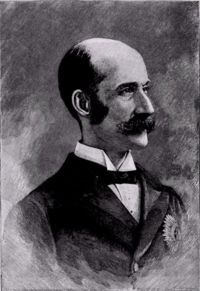Lansdowne Bridge
Originally known as the Sukkur Bridge and renamed the Lansdowne Bridge on inaugeration in 1889, this was a railway bridge over the River Indus in upper Sind which connected the towns of Sukkur and Rohri.
The Indus Valley State Railway had reached Sukkur in 1879 and the steam ferry that transported eight wagons at a time across the Indus between Rohri and Sukkur was found to be cumbersome and time-consuming. The opening of the 'Lansdowne Bridge' in 1889 solved this bottleneck and thus port of Karachi was connected to the railway network.
Alexander Meadows Rendel, Consultant Engineer was then called in and he proposed a design consisting of two anchored cantilevers, each 310 feet (94M) long, carrying a suspended span of 200ft (61M) in the middle. This design was considered feasible and Westwood, Baillie and Co of London commenced the steelwork for the girders [1] [2] [3]
Construction started in 1887 with the arrival of the steelwork and when it was completed in 1889 was the largest cantilever bridge in the world, the bridge came to be known as the 'Lansdowne Bridge'[4]. The bridge provided the railway link between Lahore, in the heart of the granary of British India, and the port of Karachi on the Arabian Sea.
Contents
Opening
It was named after Lord Lansdowne, the Viceroy at that time. The bridge was opened by Lord Reay, Governor of Bombay on 25 March 1889.
Chronology
- 1872-74: First site survey is made of Rohri-Sukkur area by James Ramsay of the Public Works Department to bridge the River Indus here. He proposed a 650 feet(200M) long suspension bridge.
- 1875: The survey was continued by Major General Sir James Browne who recommended a stiffened suspension bridge with cables formed of steel links and a span of 786ft(238M).
- 1879: Railways reached Sukkur from Karachi and Sir Guilford Molesworth suggested a three-hinged arched bridge. James Richard Bell suggested a parallel truss cantilever bridge with a main span of 680ft(206M). These schemes were considered unsatisfactory and shelved.
- 1882: A scheme of a bridge with 250ft(76M) spans supported on masonry piers was proposed. This design was almost chosen when a severe flood in the river took its bed depth down to 100 ft and this design was shelved.
Finally the Alexander Meadows Rendel design was adopted.
- 1885: The Indus channel between Sukkur and Bukkur island got bridged.
- 1887: The steel work for the Lansdowne Bridge started to reach Sukkur from the Westwood, Baillie & Co. of London. The bridge construction was then started under the supervision of Frederick Ewart Robertson and his assistant Hecquet. Their names are written to date on a plaque on each cantilever of the bridge [4].
- 1887 May: Bed plates for the Bukkur side of the Lansdowne bridge Cantilever arrived by the end of month.
- 1887 September: Full supply of steel works for the Rohri side cantilever arrived at the site.
- 1889 March 19: Lansdowne bridge was tested by running coupled L class locomotives and a train giving a gross load of 786 tons or about 1 ton per foot.
- 1889 March 25: Inauguration of Lansdowne Bridge.
- 1910: Bridge strengthening was carried out to increase the load it could carry.
- 1924: Permissible speed of trains on the bridge was reduced by 8 kmph (5 mph), after deformation and temperature stress was discovered.
- 1936: Harold Wood Robinson who was deputy chief engineer of bridges, prepared an outline design for a two hinged arch design to replace Lansdown bridge. The drawing was prepared in the Bridge office in Moghalpura, Lahore but this project didn’t see light of the day.
- 1939: Bridge strengthening was carried out to increase the load it could carry. This time 200 tons of dead weight of the bridge was removed.
Records
An on-line search of the India Office Records (IOR) records held at the British Library relating the bridge constructions over the River Indus [5] gives the following:-
- Z/E/4/22/R463; “Rivers, Indus, Construction of bridge over”; 1851-52
- Z/E/4/23/R595; “Rivers, Indus, Bridges constructed over”; 1852-53
These records have not been examined and may provide additional information
References
- ↑ Grace's Guide "Westwood, Baillie and Co" ; Retrieved on 11 Jul 2016
- ↑ Wikipedia " Westwood, Ballie"; Retrieved on 11 Jul 2016
- ↑ "All Things Pakistan - Lansdowne Bridge, Sukkur"; Retrieved on 23 Apr 2016
- ↑ 4.0 4.1 Wikipedia "Lansdowne Bridge, Rohri"; Retrieved on 23 Apr 2016
- ↑ “British Library Archives and Manuscripts Catalogue” - Search; Retrieved 23 Apr 2016


